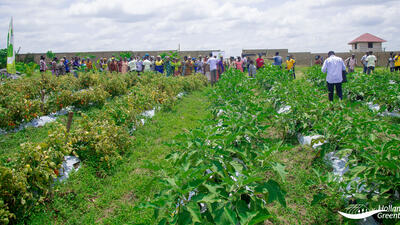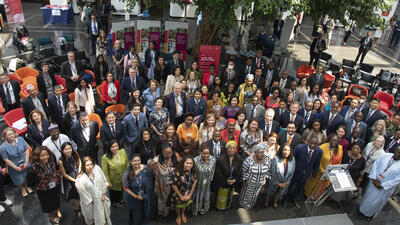Estrategia de productores y expertos para el sector del ñame ghanés (en)
When SalamaTulari sat at her roadside shed in Tamale peddling yams and wondering how she'd ever come up with the money to expand her business, she never imagined her voice would help determine the future of Ghana's strategy to develop its yam industry.
But now, as a participant in the GhanaianYamStrategy for Rural Development, Tulari has added her voice to those of hundreds of others from the rural and farming population spelling out just what is needed to improve the production and commercialization of yams and related crops in Ghana. The project, carried out by the Government of Ghana in partnership with ITC and the International Institute of Tropical Agriculture (IITA), will early next year give birth to the West African country's first sector-development strategy for yam production systems and associated crops with stakeholder ownership and leadership. The government's plan is to massively increase the country's yam commercialization and value addition. While Ghana is the world's second-largest yam producer after Nigeria, only 30,000 tons of its total production of seven million tons are currently exported.
'We're looking at value addition,' said SarkodieOsei, a yam exporter who sits on the Coordinating Committee, a private-public platform for the strategy's management and implementation. A wide rangeof products centred on yam 'are going to open up new markets in different parts of the world that we have never thought of exporting to with the traditional fresh yam that we are exporting at the moment', he said.For example, negotiations are already under way between the Ghanaian private sector and noodle buyers in Nigeria, Turkey and Japan, as well as in Ghana itself, according to IITA yam breeder Antonio Lopez.
With agriculture accounting for a third of Ghana's GDP and employing more than half the country's workforce - 70% of them women - the government and private-sector stakeholders asked ITC and IITA to design a stakeholder-led plan thatwould underpin efforts to boost yam exports and pry open new markets.
'This process is not about creating a plan that is submitted to government and then is used unilaterally by domestic or international implementing partners or by funding partners,' said Hernan Manson, ITC adviser for strategy and value chain development. 'It's about involving the actual beneficiaries to ensure that the plan is not only right, but that it also gets implemented in the right way.'
While yam is a staple in the diet of Ghanaians and other West Africans, who boil, fry and roast the tuber, it can also be used in products such as ice cream, pasta, high-quality flour, beer, wine and cosmetics, and its starch can replace modified starches in industrial processes. TheYam Strategy focuses not just on food security, but also on identifying ways for the food-processing industryto increase the incomes and improve the livelihoods of people atdifferent points on the value chainby adding value to yam crops, according to Lopez, who has extensive experience in yam and agricultural research for development.
ITC's approach to sector-strategy development is to involve the private sector not only in consultations, but also in decision-making, to ensure that the strategy addresses real needs, Manson said. Other partners in developing the Yam Strategy include Turkey's Foreign Economic Relations Board and Argentina's Regional Consortiums of Agricultural Experimentation, which participated in a scoping tour of Ghana's yam value chain and a national workshop, and shared information on market/buyer requirements and agro-processing opportunities.
The Yam Strategy is based on the conviction that listening to the voice of the farming, investor and entrepreneurial population is essentialbecause private-sector actors will only be prepared to take risks - financial or otherwise - if they believe they have a good chance of success, and the best way to convince them of this is to let them help devise policy, Mansonexplained. ITC workedon the preparation of national and/or sector strategies in nine countries in 2012, employing thisunique participatory methodology.
Such dialogue between stakeholders is helpful in building trust between the parties, according toAnthony Sikpa, acting chief executive ofthe Federation of Association of Ghanaian Exporters and chairman of the Yam Strategy Coordinating Committee. 'The public sector and private sector are not the best bedfellows,'Sikpa said. 'People initially felt threatened, because they feared losing their comfort zone, but the mistrust is slowly melting. We seem to understand each other better and we are all gaining from the interactive nature of the intervention.''
Several workshops were held in Ghana in 2012 bringing togetherfarmers, exporters, local and international buyers, processors, TSIs, customs officials, donors, bankers, government representatives and research centres. The aim was to identify and prioritize the yam sector's problems, taking into consideration gender aspects, the environment and rural development. Participants set objectives such as making the management of farmer associations more professional, improving commercialization strategies, exploring product diversification possibilities and improving access to finance.
The difficulty of securing financing is one of the biggest obstacles preventing yam growers and traders from reaching their full potential, according to Tulari. And while all smallholder farmers and traders struggle to obtain funding, she believes banks are particularly tough on women.
'As a trader, my main problem is the financial aspect, how to expand my business,' she said after participating in a rural workshop. 'It's difficult getting financial assistance, so what I have, what I trade, is small, small. I face financial problems, like support from any of the financial institutions. For instance, when you go in for a loan, they ask for collateral, and if even they will give you, the interest rate is always high. So you can't make it if you take that loan.'
Furthermore, she says, financial institutions typically ask women how many children they have when they apply for loans. Tulari says her applications for funding have been rejected because banks fear she'll use the money on her home or children rather than on her business.
Ghana'sYamStrategy aims to address these challenges and more. Building on stakeholder decisions made during the initial participatory workshops, the Government, ITC, IITA and the Coordinating Committee began work on detailed feasibility studies based on the target markets identified as prioritiesand in-depth research examining value addition, logistics, production zones and pilot areas. Other post-workshop steps include industrial testing and adaptation of potential new products, resource mobilization and negotiations with partners, and crafting an agreement with partners on implementing modalities, timelines and outputs.
'There is a human element embedded in the whole strategy,' Manson said. 'The process is not just about getting the right statistics, but about getting the right platform, a real private-public partnership.This helps to ensure sustainability; they are driving their own future.'















